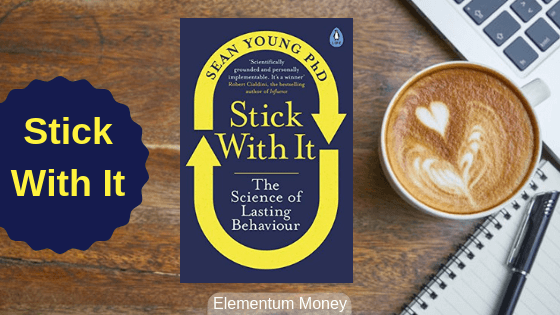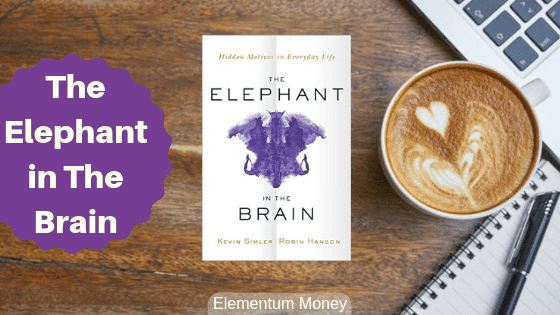January is probably the one month in the calendar that most of us are still optimistic about making progress on New Year Resolutions. As the year fades out, so does our enthusiasm to keep up with them. New Year Resolutions can be summed up in one word – Habits. Want to lose weight? Count your calories (intake and burn). Want to save more money? Track your expenses. Want to start your day early? Stop watching Netflix before bed. Want to find the time to learn a new skill? Stop spending all your free time browsing social media and playing games on your phone.
However, we all know that these habits are easier said than done. What is it that makes bad habits so difficult to break off from and good habits so difficult to initiate in our lives? Is it merely passion or will power or can we do some thing to make it stick? This, in a nutshell, is what Dr. Sean Young discusses in his fantastic, concise read – Stick with it: A Scientifically Proven Process for Changing Your Life-for Good.
Who is Dr. Sean Young?
Sean Young is one of those high achievers who sound too good to be true. Don’t believe me? Check out the first paragraph of the bio from his website: Sean Young, PhD, MS, is the Executive Director of the University of California Institute for Prediction Technology, the UCLA Center for Digital Behavior, a Medical School Professor with the UCLA Department of Family Medicine, and the #1 Wall Street Journal and National Best-Selling author of Stick With It.
Having read his book where he talks about some of his work, helping app designers make their app more usable and sticky for users, and heard him on a podcast, I can truly say I am a fan. His work really talked to me and the science-based approach of seven levers to forming habits and the three kinds of habits, while initially seemingly complicated, is a good roadmap to inculcate the desired habits for the truly determined.
Three Types of Habits
Dr. Sean Young segments habits into an easy A-B-C categorization though the lines are a little blurred and for some habits, it can be a little difficult to understand which bucket to put it in, especially between the A and the B:
Automatic Behaviour
Automatic habits are the unconscious habits that we adopt, when we don’t even realize we are doing it. For instance, biting nails when nervous, raising your voice at the hint of an argument etc. In some ways, your brain needs no conscious action on your part for you to indulge in that habit.
Burning Behaviour
Burning Habits are the ones where there is a trigger following which you feel that itch to indulge in a habit. For instance, wanting that one cigarette after lunch, wanting to check email as soon as you wake up.
Common Behaviour
These are the habits indulged in, frequently and consciously. They are not as
Seven Levers to Forming Habits
The basis to the book is the idea that there are seven possible factors which impact the probability of a habit becoming sticky. These seven factors come together conveniently in the acronym S-C-I-E-N-C-E. After an introduction, the book devotes a chapter to each of these factors with insightful anecdotes and examples making it a breezy yet impactful read.
Stepladders
Stepladders is the idea that when we look at a new habit or even reducing a bad habit, going at it all in one go is not really ideal. Often enough, we may realize the magnitude of the task at hand, get disheartened with the lack of progress and decide to leave it altogether. Instead, it is ideal to take baby steps. For instance, you generally wake up at 7 in the morning but having read one of the “Successful people start their day at 4 am” article, you decide to wake up at 4 am too, and see for yourself the benefits of being a morning person. You continue to play a game and sleep at the usual sleep time at midnight. Next morning, you are bound to wake up groggy. Instead, you need to ensure you start out with sleeping 15-30 minutes earlier at night and waking up just 15-30 minutes before your regular time. Start with such steps and gradually move on to improvements instead of taking any drastic action.
Community
This is a big one, especially for habits that we are consciously trying to change. If you have people on the same path as you, the newness of the task seems less intimidating and any progress seems even better with the sharing of it. In some ways, the feeling of community that we humans so seek, is what helps social media thrive. It is a well known fact that probability of people sticking to a resolution of working out more works better if they have a buddy at gym.
Important
What does the habit mean to you? Here too, I believe you must start with why. Why do you want to lose weight? Is it the fear of having issues in old age the way you see in your family? Starting with why and remembering the reason will make it more probable for you to carry on with the habit. Unless a habit is important, and unless you remember why it is important, chances are you will go off track, sooner or late. Another thing mentioned in the chapter is how different factors motivate different people. For some, money is important whereas for others it’s about health and for a few others it is more to do with social approval. If you are looking to make a habit or behavior stick, like wanting customers to use your product, it is crucial to understand the critically important factor here so that the carrot is right.
Easy
To me, this and Neurohacks are two very important and interconnected factors. There are two schools of thought when it comes to habits – one which believes that your probability of following through a habit is dependent only on your passion and will power and the other which believes that following through on a habit depends on whether you can make things easy on yourself. Dr. Sean Young clearly believes making it easy to follow through on a habit or behavior is a key element in forming long-lasting change. In this chapter, he talks about creating the right environment for yourself. For instance, if you are looking to cut down on junk food, ensure you do not keep any of it in the house, even for cheat days. If you are looking to save more, start a SIP so that every month you get habituated to working around with the remaining money. If you want to start blogging in the limited time outside of work, you could look at uninstalling entertainment apps. Easy really means taking steps to make the environment conducive and removing temptations to following through on the desired behavior.
Neurohacks
This was one of the most interesting aspects of the S-C-I-E-N-C-E model for me. In some of the latest psychological research, one of the new conclusions is the fact that the body often inspires the brain rather than just vice versa. So, if you are in a funk of a mood, instead of telling yourself to improve your mood, twisting your lips in a smile for a longer time could actually prove to be helpful. A lot of the days if I wake up not wanting to go to the gym, I often tell myself that I will go there and chill. As you can imagine, once I have packed my bag and reached the gym, the mind tells me to work out. This is a particularly useful step for addictions whereby with a small behavior change, we are able to tell our mind that our body can do without something.
Captivating
To me, captivating can be summed up in one buzz word – Gamification. The idea is that starting a new habit should get the person truly invested. That’s why random achievement badges in apps and some idea of progress works well. Gamification could work in savings as well. With a lot of the habits that I now track in my bullet journal, I now find the practice of filling into vibrant
Engrained
There is a popular theory as per which 21 days is the time that it takes for a habit to become truly permanent for us. While the number may be suspect, the fact remains that the more you do of a habit, it gets more engrained into our brains. Gradually, it becomes pretty instinctive and we just need to use the faster part of our brain, instead of the slow languorous one. As a child, brushing or bathing was a task and it took our parents quite long to habituate us towards it. Over the years, there have been mornings when I have literally sleepwalked with my eyes closed and yet brushed my teeth first thing as soon as I got out of bed.
So, if this year you are looking to turn over a new leaf, break out of bad habits or engrain new habits, start with identifying it from the A-B-C categories. Dr. Sean Young also talks about which of the S-C-I-E-N-C-E model factors are better suited for which type of behavior. For that though and a far better details understanding of the S-C-I-E-N-C-E model, you must read the book.
In case, you are looking at a cheat code to making lasting changes without reading the book, Jordan Harbinger has been generous enough to have this super helpful cheat sheet freely available.
Have you read the book? What did you make of it? Let me know in the comments below.





Leave a Reply